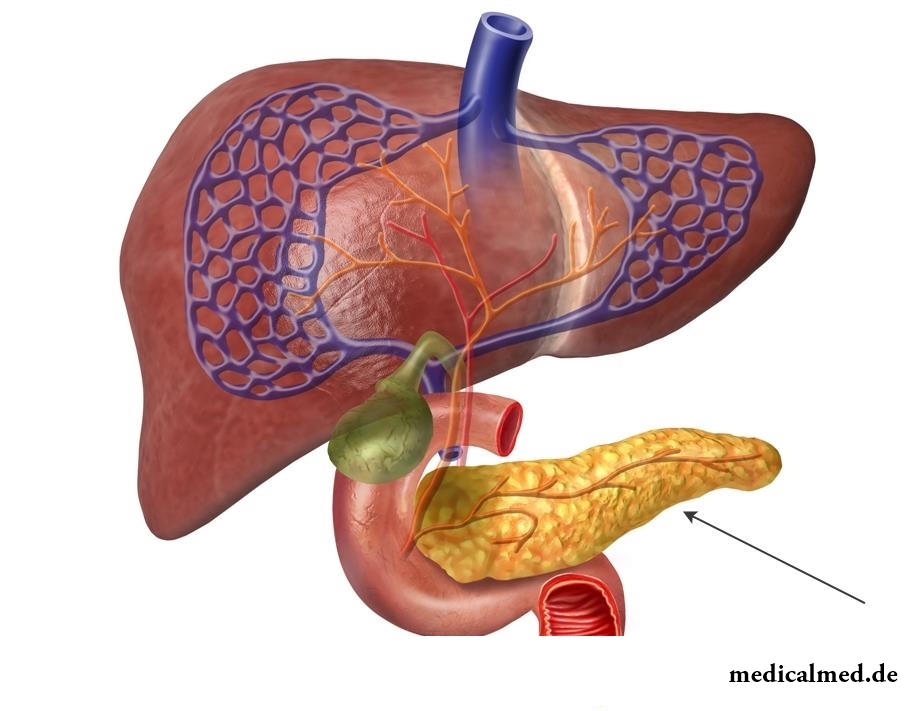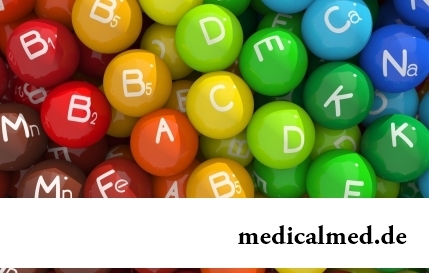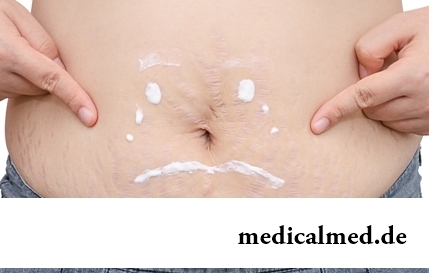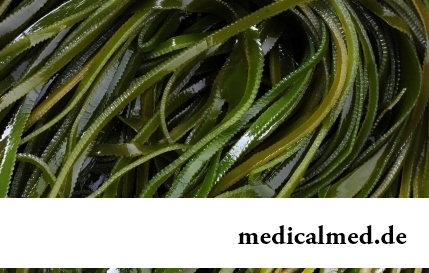





Pancreas
Pancreas – the large closed and digestive gland located behind a stomach, at the level of upper chest and lower lumbar vertebrae. The pancreas weighs 70-80 g, length of its 10-23 cm, width around a head – 3-9 cm, thickness - 2-3 cm.

Pancreas structure
This body consists of three main departments: heads with an ankyroid shoot, a body and a tail – the narrowest part of gland. Between a body and a head the narrowed part of gland – a neck is located.
Gland head having the hammer form is placed in a duodenum arch. Behind a head there pass blood vessels.
Gland body the back surface adjoins to a left kidney, retroperitoneal cellulose and an adrenal gland, bending around a backbone at the level of the first or second vertebrae of lumbar department.
Pancreas tail usually narrow, a little rounded off and raised up. In the place of contact of a tail with a greater cul-de-sac there is a small deepening.
In the thickness of gland (from a head to a tail) there passes the channel falling into a duodenum.
The structure of this body allocates two types of fabric - a parenchyma (ferruterous fabric) and a stroma (connecting fabric). The parenchyma of gland is presented by numerous segments of irregular shape, and also the cellular sites having rounded shape (islets of Langerhans). Ferruterous (secretory) cells of segments produce pancreatic (pancreatic) juice. The most important food enzymes – trypsin, a lipase, amylase are a part of this secret. Insular cells synthesize hormones (a glucagon and insulin).
Functions of a pancreas
This gland, being body external and incretion, performs at the same time exocrine and endocrine functions.
The pancreas takes part in digestion process. The site of gland participating in digestion through the main channel produces pancreatic juice directly in a duodenum. The exocrine site of gland cosecretes at the person for days 0,5-0,7 l of a gastric juice.
Effect of islets of Langerhans is similar to action of closed glands. They emit in a blood stream insulin and a glucagon - the hormones regulating carbohydrate metabolism. Insulin has anabolic effect. Besides, it promotes education by lipocytes and hepatocytes of triglycerides from fatty acids. Similar action also the glucagon possesses, however it at the same time stimulates oxidation of triglycerides in hepatocytes, promoting formation of ketonic bodies. Constant level of glucose in blood within 800-1000 mg/l is regulated by a glucagon and insulin.
Pancreas diseases
The inflammation of a pancreas can result from an alcohol abuse, spicy, fried and greasy food. Frequent stresses and an overeating can also be the inflammation reasons.
The inflammation of a pancreas can proceed both in acute, and in a chronic form (chronic and acute pancreatitis).
The inflammation in a chronic form quite often develops into very dangerous diseases of a pancreas – a cyst, tuberculosis, abscess, a diabetes mellitus, a pancreatic cancer.
The pancreas inflammation sometimes is a consequence of various infectious diseases, parasitic invasions, kolleganovy diseases, metabolism diseases. Diseases of language, gums increase risk of development of a pancreatic cancer.
Appetite loss, emergence of red spots on skin of a breast, a stomach, a back, sharp decrease or fervescence, vomiting, nausea, a xeroderma, fragility of hair and nails, an eructation belong to clinical displays of diseases of a pancreas.
Treatment of a pancreas
During remission, and also during recovery (after the previous aggravations) it is very important to keep to a diet for prevention of a recurrence and treatment of a pancreas.
In addition to a diet to the patient usually appoint drug treatment of a pancreas: the medicines which are reducing fermental activity, removing a spasm of unstriated muscles of channels of gland, and also calming and anesthetizing drugs.
Benign tumors (fibromas, adenomas, lipomas) most often delete in the surgical way. A pancreatic cancer also treat by surgical methods with the subsequent carrying out chemotherapy and postoperative radiation.
Distinguish palliative and radical operations. Carry a resection of a tail and body of gland, pankreatoduodenalny resections, a total pancreatoduodenectomy to radical operations. Palliative operations are carried out for improvement of quality of life of patients and are directed to elimination of mechanical jaundice, a pain syndrome, impassability of a duodenum.
In our intestines are born, millions of bacteria live and die. They can be seen only at strong increase, but if they gathered, then would be located in a usual coffee cup.

Such trouble as the milkwoman's attack, at least once in life happened almost to each woman. Prevalence забол...
Section: Articles about health
The nature does not stand stagnation and monotony. It is known that tissues of a human body atrophy if do not receive necessary loadings. It fully belongs also to a cerebral cortex: when it is not given full-time job, it begins to function worse. In резуль...
Section: Articles about health
Aspirin (acetylsalicylic acid) – one of those drugs which are known literally to all. It is available in each home first-aid kit, and many accept it at the first signs of an indisposition, often without having a fair idea of properties and therapeutic effect of drug. Meanwhile, impact of aspirin on a human body is very various, and is not always favorable. About it it is important to foreknow, in order to avoid emergence of problems with health....
Section: Articles about health
Vitamin complexes belong to the most popular drugs, probably, in our country there is no person who was not hearing about a floor...
Section: Articles about health
Transfusion of donor blood has almost century history. In spite of the fact that this procedure is quite usual for many people, process of blood donation is still surrounded with numerous myths. Today we aimed to discredit the most widespread of them....
Section: Articles about health
Statistically cystitis 25-30% of women up to 40 years have. With age this indicator raises, besides many do not get to statistics because do not see a doctor. The most sad that after the regular visits to doctors, long reception of antibiotics and life in the mode "it is necessary to take care" cystitis all the same is returned to a half of women. Symptoms of cystitis are unambiguous and it is impossible to confuse them with anything: bladder pain, burning at an urination, frequent desires to go to a toilet, a vynuzhd...
Section: Articles about health
Dietary supplements (dietary supplements) for the last decades were so thoroughly included into our life that, apparently, it is already impossible on...
Section: Articles about health
Smoking not only exerts a negative impact on the state of health of the consumer of tobacco products, but is an air polluter the substances potentially dangerous to people around. In recent years significantly the number of people, стремящ increased...
Section: Articles about health
The naturopathy sometimes moves as the new direction of medicine, something like fashionable hobby, and there is nothing farther from the truth. This most ancient direction, the word "naturopathy" is translated as "treatment by the nature", and, no doubt, treatment by natural gifts was the first and only, available to the person in ancient times. Despite modern achievements of medicine, the naturopathy remains urgent and today, anyway the person - a part of the nature, and природн...
Section: Articles about health
Modern footwear is extremely various. It stopped being only protection for legs long ago. Today shoes, boots, barefoot persons in...
Section: Articles about health
Iodine - one of thirty most important microelements in our organism. The main role of iodine consists in synthesis of thyroid hormones of a thyroid gland - the substances which are responsible for the majority of exchange processes of an organism. It is known that thyroid hormones consist...
Section: Articles about health
Good appetite was always considered as a sign of good health. The correct operation of the mechanism which is responsible for the need for nutrients and receiving pleasure from process of its satisfaction demonstrates that the organism functions without special deviations. On the other hand, appetite of the person is not a constant. It depends on the culture of food, flavoring addictions imparted since the childhood which can change during life, weather, mood and many д more than once...
Section: Articles about health
Each person supports all life a SARS about 200 times. The peak of incidence falls on cold season, but to get sick from temperatures...
Section: Articles about health
Feeding by a breast - the integral part of ideal motherhood allowing to come into contact with the kid and to create to it healthy immunity since early years. Nevertheless, this important process in life of mother and child can be saddened laktostazy − by a delay of milts...
Section: Articles about health
No, probably, the person who would not have cold. Cold, cough, a headache – these symptoms are known to everyone. The peak of catarrhal diseases is the share of fall. SARS already came to schools and kindergartens, flu slowly makes the way to the cities, in a word, winter close!...
Section: Articles about health
At this plant there are a lot of names: tuberiferous sunflower, Jerusalem artichoke, solar root, earth pear. Contrary to spread...
Section: Articles about health
Memory is an ability of the central nervous system to fix, keep and as necessary to reproduce information on knowledge or skills received by the person or an animal during life. The mechanism of this process is up to the end not studied....
Section: Articles about health
High temperature - a frequent symptom of such widespread diseases as a SARS, quinsy, pneumonia, etc. To reduce heat, having facilitated a condition of the patient, doctors recommend to accept antipyretics, however their use is not always possible. Too frequent use of these drugs can lead to allergic reactions, and also overdose, causing poisoning. It happens also that there are no antipyretics simply in the house. In these situations it is pertinent to use it...
Section: Articles about health
Bathing in broths of medical flowers and plants (phytobathtub) was eurysynusic since Cleopatra who is a good judge of everything...
Section: Articles about health
Residents of big cities quite often have a disease which is known as the syndrome of chronic fatigue (SCF) today. This illness affects the people belonging to various social and demographic groups and living on all continents. Most of all SHU to a podverzha...
Section: Articles about health
Life of the modern woman is very difficult. Opportunities to realize itself are wide: it not only education and career, but also the most various hobbies from sport before needlework. It is not less important to build private life, paying an attention maximum to children, the husband, parents, friends. For all these affairs there is catastrophically not enough time therefore each of us tries to cut down as far as possible its expenses on necessary, but not the most fascinating housework. With it we are successfully helped by means...
Section: Articles about health
Each failure in work of bodies and systems of a human body is, as a rule, shown by the whole complex of symptoms. In particular, N...
Section: Articles about health
Striya (extension) are the defects of skin having an appearance of direct or wavy strips from 1 to 10 cm long and 1-5 mm wide. In most cases at women of a striya are located on a stomach, hips, a breast or buttocks. At athletes they can appear on shoulders and внутренн...
Section: Articles about health
The brain of the person is studied not one hundred years, but the quantity of the riddles connected with this body increases rather, than decreases. Perhaps, numerous delusions concerning a structure and functioning of a brain are explained by it, many of which arose long ago, but continue to exist and today. Such we are ready to acquaint readers with the most widespread myths....
Section: Articles about health
The medicine promptly develops, and the fact that else quite recently it seemed by miracle can now. We are not surprised any more to the fact that sport...
Section: Articles about health
With age in a human body harmful substances collect. We receive them with food and water, at inhalation of the contaminated air, reception of medicines, use of household chemicals and cosmetics. A considerable part of toxins accumulates in a liver, osnovno...
Section: Articles about health
For residents of the countries of Southeast Asia various algas are an obligatory component of a daily diet. Their popularity is connected not only with high tastes, but also with numerous curative properties. Russians are a little familiar with products such that is distressing: algas are so useful that they should be eaten as often as possible. Let's get acquainted closer with useful properties of this seafood....
Section: Articles about health
